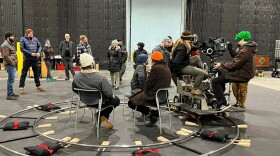In 2011, Kelly Froh and her co-founders decided Seattle was ripe for a celebration of the local underground comics scene. They set about creating the Short Run Comix Festival, a yearly celebration of underground, alternative, and DIY comic art.
Short Run allows creators to cut out the middlemen and present their work directly to the public. It welcomes artists from underrepresented backgrounds whose works deal in anything from identity, dream logic, mutants, to quotidian comedy, and everything in between.
On Saturday, Nov. 2, the 12th iteration will be held at Seattle Center’s Fisher Pavilion. For no entrance fee, from 11 a.m. to 6 p.m., curious patrons will be able to peruse the works of the artists, while the creators themselves will host their own tables of self-published comics and associated art.
What distinguishes these works from what many people still think of as “comic books” – superpowers and Spandex costumes – is not just the subject matter but also the means of production and distribution. Mini-comics aim for being a low-cost alternative to glossy trade paperbacks, usually produced by hand on photocopiers or Risograph machines by the artists themselves.
Getting Short Run off the ground also relied on low-cost alternatives.
“We were putting up posters on telephone poles,” Froh recalled of the festival’s scrappy early days, which led to more than a decade and counting of successful festivals.
“We still put up signs on telephone poles,” she added.
Over 4,000 attendees are anticipated this year, based on previous attendance, and will be able to browse the work of 250 artists, from newcomers to veterans. While the majority will be homegrown or locally based, creators from Argentina, Denmark, Japan, and Mexico will be exhibiting work as well. All in all, a veritable bonanza awaits fans of below-the-radar literary art.
To achieve this, Froh described Short Run as “anti-growth.” Its current size allows her and the rest of the board of directors, along with an advisory board of volunteers, to curate an eclectic and consistently top-tier selection of artists. This approach has also allowed the arts nonprofit to offer year-round workshops and short-term residencies for up-and-coming artists.
The festival itself presents a rare opportunity for face-to-face interactions between creators, industry folk, and the public. It's also a chance to revel in an art form that is often experienced in solitude, whether by the artist or the reader.
“It’s a mutually beneficial two-way street,” Froh said about these interactions.
In an era when nearly every artist must maintain some sort of online presence, seeing the faces behind the work and seeing the art up close can foster a sense of community while being a feast for the senses.
This year’s “featured artists” include Julia Gfrörer, whose newest collection is forthcoming on Fantagraphics; Japan’s Tetsunori Tawaraya, whose work trades in mutated forms and vibrant colors; and Seattle-based Mita Mahato, who uses collage techniques to craft her comics.
'Rise of comix'
After World War II, mainstream comics tended to foreground themes of patriotism, chivalry, and patriarchy, plus the occasional bit of vigilante justice. Generally, people assumed that comics were appropriate for young readers, but nonetheless the Comics Code Authority was formed to self-regulate content.
However, the 1954 publication of Fredric Wortham’s Seduction of the Innocents caused something of a “moral panic” in the public, and suddenly the Comics Code acquired a new gravity and significance. Though submission to the Authority was voluntary, it lent a veneer of “respectability” to mainstream comics of the time by ensuring parents and advertisers that nothing in the comics bearing its stamp would be too salacious or violent.
Most histories of the underground comics scene tend to center around the '60s countercultural milieu of San Francisco – home of Robert Crumb and his seminal Zap Comix.

Unlike their more mainstream, CCA-approved counterparts in New York City (DC Comics being foremost among them), these Haight-Ashbury denizens deigned not to conform to the standards set out by the Comics Code Authority, instead delivering deranged tales filled with lewd language and bawdy humor.
Key to this freedom was these artists’ ability to deal with contemporary political issues, with subversive and countercultural material off-limits to the caped crusaders of the time.
A decade and change later, further up the West Coast, the alternative scene continued to flourish thanks to a brilliant and dynamic cohort of artists who took up the gauntlet thrown down by earlier underground artists to pursue their own ends.
Matt Groening and Lynda Barry met at Olympia’s Evergreen College in the late ‘70s. Both would later go on to create defining works of alternative comics: Groening with Life in Hell, Barry with The Good Times are Killing Me. Barry also happened to attend high school with another future star of the underground Northwest scene: Charles Burns, who began as a cartoonist for Sub Pop before publishing his acclaimed series Black Hole, a dystopian tale of teenage sexuality set in Seattle.
Black Hole was published by Fantagraphics, an internationally recognized powerhouse independent comic and graphic novel publisher that relocated to Seattle from Los Angeles in 1989.
"This coincided with the emerging grunge youth movement which soon became an international phenomenon," said Larry Reid, a curator at Fantagraphics. "The local cartoonists community and Fantagraphics became closely associated with that cultural development."
Reid said the local comics scene has grown steadily ever since, and remains healthy in the Seattle region as successive generations apply their creativity to the medium.
Fantagraphics Bookstore & Gallery in Georgetown serves as the unofficial hub of the independent comics scene in Seattle, with Reid running an indefatigable series of indie comic showcases and community events every month.
A longtime supporter of Short Run, Fantagraphics will also host the Short Run Marathon Art Show & Pre-Fest Party on Friday, Nov. 1.
Short Run lives on
All of which leads back to Short Run, which Froh hopes has become “the best niche, alternative comics festival in the country.”
Short Run veterans recommend attending the satellite events surrounding the festival. This year, these include a featured artist showcase on Halloween, a collage workshop with Mahato on Friday, and a comic swap at Chuck’s Hop Shop in the Central District.
Next year, Short Run plans to pull up stakes and relocate to the Seattle Design Center. When that time comes, Froh has no doubt that the audience built up over the past decade and a half will be right there with the festival. Plus, with the Design Center sharing a neighborhood with Fantagraphics' shop, Short Run's own studio space and a thriving DIY art scene, she said “it feels like we’re coming home.”
In a city where cultural institutions of all stripes and sizes face uncertain futures, Short Run is going strong and optimistic about the form’s future.
“That we can count on audience for our projects, I never take that for granted," Froh said.









